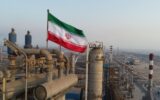Iran Oil Output Hits 3.5 mb/d

According to Mohsen Khojasteh-Mehr, CEO of the National Iranian Oil Company (NIOC), Iran’s oil output capacity would soon reach 3.5 mb/d. Majid Chegeni, CEO of National Iranian Gas Company (NIGC), has said Iran’s gas production capacity has reached 1 bcm/d, adding that gas exports to Turkey and Iraq had grown 22% and 16%, respectively. Jalil Salari, CEO of National Iranian Oil Refining and Distribution Company (NIORDC), has said that 1.6 million tonnes of Iranian equipment had been exported to overseas refineries.
Oil Exports Double
Khojasteh-Mehr has given a positive assessment of the Ministry of Petroleum in the 13th administration, saying oil exports had doubled.
Referring to the sales of 87 million barrels of condensate, he said: “We managed to sell 87 million barrels of condensate, while it was not in our strategic tanks and was kept in rented vessels, imposing $450 million in annual costs on us for its preservation. Therefore, we decided to sell condensate in order to gain revenue.” He said no condensate was parked on the water.
Khojasteh-Mehr said Iran’s oil production stood at 2.2 mb/d when the 13th administration took office, adding that the figure would grow to 3.5 mb/d soon.
NIOC has also implemented $11 billion worth of IPC deals, he said, adding that another $3.1 billion would soon be added to that figure.
He said $8 billion agreements would be signed for developing two oil fields in the second half of the current calendar year, adding: “We’re holding numerous rounds of talks for development of oil and gas fields, which pay off gradually. They are valued at $60 billion.”
Gas Diplomacy
Chegeni said Iran’s gas consumption reached 230 bcm last calendar year, adding that 98.6% of the urban and 86.3% of the rural population in Iran were under the coverage of the natural gas supply network.
He also said that gas swap from Turkmenistan had reached 8 mcm/d, adding that talks were underway for renewing gas contracts with Iraq and Turkey.
Referring to talks held with Turkmenistan, he said: “Our talks for gas imports from this country are underway for short-term and long-term periods. We hope that the short-term part would reach a conclusion soon, but we predict the long-term part to take longer.”
Chegeni said the gas swap from Turkmenistan to be delivered to Azerbaijan started from 4.5 mcm/d, which has now reached 8 mcm/d. He expressed hope for importing 10 mcm/d of gas from Turkmenistan.
He touched on Russia’s proposal to Iran for establishing a regional energy hub, saying: “As the proposal had come from Russia, we dispatched delegates there to test the waters for an energy hub. We hope to be able to push ahead with a gas hub in parallel with an energy hub.”
He said that some European countries had shown inclination for Iranian gas as demand is on the rise globally, saying: “We’ve held talks with Oman, Russia, and Pakistan about gas trading.”
Overseas Refineries
Salari said that Iranian catalysts used in gasoline production had been sent to overseas refineries. “So far, more than 1.6 million tonnes of Iranian commodities and 21 tonnes of Iranian catalyst have been exported to overseas refineries for gasoline production,” he said.
He said that overseas refineries would help Iran find market for its crude oil, adding: “In market building, we are not only looking at European markets; rather we have various scenarios under review.”
Salari said overseas refineries would enhance Iran’s crude oil exports and help sell refined Iranian oil at target markets.
“Talks have been held for cooperation with overseas refineries in Asian nations. Expert teams are active and proposals are being reviewed,” he said.
Salari said the first domestically-made compressor would be soon unveiled for use at overseas refineries, adding: “Specialized technical teams are assessing the conditions in target countries so that we can work in international markets.”
Maritime LPG Exports
Salari said that liquefied petroleum gas (LPG) exports had increased, adding that LPG exports had quitted in the past due to special conditions.
“At Bandar Abbas, 400-500 tb/d LPG export capacity was revived. In Abadan, the first LPG carrying vessel docked while offshore gas export installations were renovated there. Before that, onshore delivery was done from Abadan to Afghanistan and Pakistan,” he said.
Upgrading the quality of refined products is among important issues at 10 refineries. Salari said one case in point was fuel oil, adding that pilot projects were envisaged as agreements had been signed with knowledge-based companies.
In case of good yield from these projects, commercialization would take place and Iran would have technical knowhow to upgrade fuel oil and light crude quality.
Tags:Iran Oil Output ، Mohsen Khojasteh-Mehr ، oil
- Comments sent by you will be published after approval by site administrators.
- Comments that contain slander will not be published.
- Comments that are not in Persian or not related to the news will not be published.

Comments
Total comments : 0 Awaiting review : 0 Date: 0